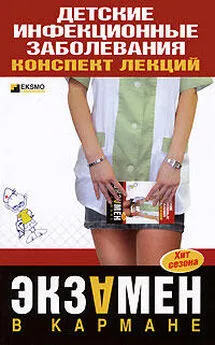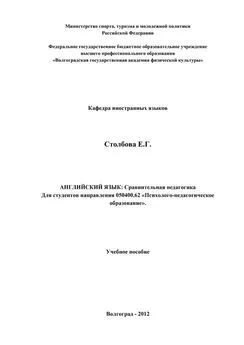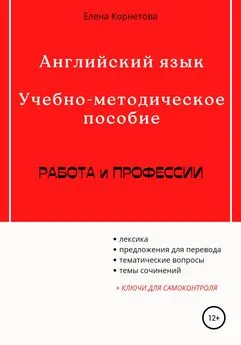Елена Беликова - Английский язык для медиков: конспект лекций
- Название:Английский язык для медиков: конспект лекций
- Автор:
- Жанр:
- Издательство:Конспекты, шпаргалки, учебники «ЭКСМО»b4455b31-6e46-102c-b0cc-edc40df1930e
- Год:2007
- Город:Москва
- ISBN:978-5-699-20181-5
- Рейтинг:
- Избранное:Добавить в избранное
-
Отзывы:
-
Ваша оценка:
Елена Беликова - Английский язык для медиков: конспект лекций краткое содержание
Представленный вашему вниманию конспект лекций предназначен для подготовки студентов медицинских вузов к сдаче экзамена. Книга включает в себя полный курс лекций по английскому языку, написана доступным языком и будет незаменимым помощником для тех, кто желает быстро подготовиться к экзамену и успешно его сдать.
Английский язык для медиков: конспект лекций - читать онлайн бесплатно ознакомительный отрывок
Интервал:
Закладка:
20. We wrote. test in… mathematics.
Answer the questions.
1. What component of blood is plasma?
2. What components does the plasma have?
3. Where do large blood proteins remain?
4. Do large blood proteins equilibrate with the interstitial fluid?
5. What colour is serum?
6. Where is serum separated from?
7. What com position does the serum have?
8. What do lymphatic vessels consist of?
9. How do lymphatics serve?
10. How is developed the smooth muscle in large lymphatic ducts?
Make the sentences of your own using the new words (10 sentences).
Find the definite and indefinite articles in the text.
ЛЕКЦИЯ № 17. Hematopoietic tissue
Hematopoietic tissue is composed of reticular fibers and cells, blood vessels, and sinusoids (thin-walled blood channels). Myeloid, or blood cell-forming tissue, is found in the bone marrow and provides the stem cells that develop into erythrocytes, granulocytes, agranulo-cytes, and platelets. Red marrow is characterized by active hematopo-iesis; yellow bone marrow is inactive and contains mostly fat cells. In the human adult, hematopoiesis takes place in the mar row of the flat bones of the skull, ribs and sternum, the vertebral column, the pelvis, and the proximal ends of some long bones. Erythropoiesis is the process of RBC formation. Bone marrow stem cells (colony-forming units, CFUs) differentiate into proerythroblasts under the influence of the glycoprotein erythropoietin, which is produced by the kidney.
Proerythroblast is a large basophilic cell containing a large spherical euchromatic nucleus with prominent nucleoli.
Basophilic erythroblast is a strongly basophilic cell with nucleus that comprises approximately 75% of its mass. Numerous cytoplasmic polyribosomes, condensed chromatin, no visible nucleoli, and continued hemoglobin synthesis characteristics of this cell.
Polychromatophilic erythroblast is the last cell in this line undergoes mitotic divisions. Its nucleus comprises approximately 50% of its mass and contains condensed chromatin which appears in a «checker-board» pattern. The polychnsia of the cytoplasm is due to the increased quantity of acidophilic hemoglobin combined with the basophilia of cytoplasmic polyribosomes.
Normoblast (orthochromatophilic erythroblast) is a cell with a small heterochromatic nucleus that comprises approximately 25% of its mass. It contains acidophilic cytoplasm because the large amount of hemoglobin and degenerating organelles. The pyknotic nucleus, which is no longer capable of division, is extruded from the cell.
Reticulocyte (polychromatophilic erythrocyte) is an immature aci-dophilic denucleated RBC, which still contains some ribosomes and mitochondria involved in the synthesis of a small quantity of hemoglobin. Approximately 1% of the circulating RBCs are reticulocytes.
Erythrocyte is the mature acidophilic and denucleated RBC. Erythrocytes remain in the circulation approximately 120 days and are then recycled by the spleen, liver, and bone marrow.
Granulopoiesis is the process of granulocyte formation. Bone marrow stem cells differentiate into all three types of granulocytes.
Myeloblast is a cell that has a large spherical nucleus containing delicate euchromatin and several nucleoli. It has a basophilic cytoplasm and no granules. Myeloblasts divide differentiate to form smaller pro-myelocytes.
Promyelocyte is a cell that contains a large spherical indented nucleus with coarse condensed chromatin. The cytoplasm is basophilic and contains peripheral azurophilic granules.
Myelocyte is the last cell in this series capable of division. The nucleus becomes increasingly heterochromatic with subsequent divisions. Specific granules arise from the Golgi apparatus, resulting in neu-trophilic, eosinophilic, and basophilic myelocytes.
Metamyelocyte is a cell whose indented nucleus exhibits lobe formation that is characteristic of the neutrophil, eosinophil, or basophil. The cytoplasm contains azurophilic granules and increasing numbers of specific granules. This cell does not divide. Granulocytes are the definitive cells that enter the blood. Neutrophilic granulocytes exhibit an intermediate stage called the band neutrophil. This is the first cell of this series to appear in the peripheral blood.
It has a nucleus shaped like a curved rod or band.
Bands normally constitute 0,5-2% of peripheral WBCs; they subsequently mature into definitive neutrophils.
Agranulopoiesis is the process of lymphocyte and monocyte for mation. Lymphocytes develop from bone marrow stem cells (lympho-blasts). Cells develop in bone marrow and seed the secondary lympho-id organs (e. g., tonsils, lymph nodes, spleen). Stem cells for T cells come from bone marrow, develop in the thymus and, subsequently, seed the secondary lym phoid organs.
Promonocytes differentiate from bone marrow stem cells (mono-blasts) and multiply to give rise to monocytes.
Monocytes spend only a short period of time in the marrow before being released into the bloodstream.
Monocytes are transported in the blood but are also found in connective tissues, body cavities and organs.
Outside the blood vessel wall, they are transformed into macropha-ges of the mononuclear phagocyte system.
Thrombopoiesis, or the formation of platelets, occurs in the red bone marrow.
Megakaryoblast is a large basophilic cell that contains a U-shaped or ovoid nucleus with prominent nucleoli. It is the last cell that undergoes mitosis.
Megakaryocytes are the largest of bone marrow cells, with diameters of 50 mm or greater. They undergo 4-5 nuclear divi sions without concomitant cytoplasmic division. As a result, the megakaryocyte is a cell with polylobulated, polyploid nucleus and abundant granules in its cytoplasm. As megakaryocyte maturation proceeds, «curtains» of platelet demarcation vesicles form in the cytoplasm. These vesicles coalesce, become tubular, and eventually form platelet demarcation membranes. These membranes fuse to give rise to the membranes of the platelets.
A single megakaryocyte can shed (i. e., produce) up to 3,500 platelets.
New words
reticular – сетчатый
sinusoids – синусоиды
granulocytes – гранулоциты
agranulocytes – агранулоциты
active – активный
yellow – желтый
glycoprotein – гликопротеин
erythropoietin – эритропоэтин
large – большой
amount – количество
hemoglobin – гемоглобин
degenerating – вырождение
capable – способный
division – разделение
spherical – сферический
indented – зазубренный
condensed – сжатый
chromatin – хроматин
Запомните следующие застывшие словосочетания.
to play _ chess to play the piano to play _ football to play the guitar out of _ doors
Запомните, что перед обращением артикль опускается.
Е. g. What are you doing, _ girls?
Заполните пропуски, где необходимо.
1. Do you play… piano?
2. There is… big black piano in our living-room.
3. It is at… wall to… left of… door opposite… sideboard.
4. My mother likes to play. piano.
5. She often plays… piano in… evening.
6..boys like to play… football.
7. What do you do in… evening? – I often play… chess with my grandfather.
8. Where are… children? – Oh, they are out of… doors… weather is fine today.
9. They are playing… badminton in… yard.
10. What… games does your sister like to play?
11. She likes to play… tennis.
12. Do you like to play… guitar?
13. What… colour is your guitar?
14. When we want to write… letter, we take… piece of… paper and… pen.
15. We first write our… ad dress and… date in… right-hand corner.
16. Then on… left-hand side we write… greeting.
17. We must not forget to leave… margin on… left-hand side of… page.
18. On… envelope we write… name and address of… person who will receive it.
19. We stick… stamp on… top of right-hand corner.
20. We posted… letter.
Answer the questions.
1. What is hematopoietic tissue composed of?
2. Where is myeloid found?
3. How is red marrow characterized?
4. What does yellow bone marrow contain?
5. Where does hematopoiesis takes place in the human adult?
6. What is erythropoiesis?
7. What is myeloblast?
8. What is band neutrophil?
9. How long are megakaryocytes?
10. How many platelets can a single megakaryocyte shed?
11. Make the sentences of your own using the new words (10 sentences).
12. Find the definite and indefinite articles in the text.
ЛЕКЦИЯ № 18. Arteries
Arteries are classified according to their size, the appearance of their tunica media, or their major function.
Large elastic conducting arteries include the aorta and its large branches. Unstained, they appear yellow due to their high con tent of elastin.
The tunica intima is composed of endothelium and a thin sub jacent connective tissue layer. An internal elastic membrane marks the boundary between the intima and media.
The tunica media is extremely thick in large arteries and con sists of circularly organized, fenestrated sheets of elastic tissue with interspersed smooth muscle cells. These cells are responsi ble for producing elastin and other extracellular matrix com ponents. The outermost elastin sheet is considered as the external elastic membrane, which marks the boundary between the media and the tunica adventitia.
The tunica adventitia is a longitudinally oriented collection of colla-genous bundles and delicate elastic fibers with associated fibroblasts. Large blood vessels have their own blood supply (vasa vasorum), which consists of small vessels that branch profusely in the walls of larger arteries and veins. Muscular distributing arteries are medium-sized vessels that are characterized by their predominance of circularly arranged smooth muscle cells in the media interspersed with a few elastin compo nents. Up to 40 layers of smooth muscle may occur. Both internal and external elastic limiting membranes are clearly demonstrated. The intima is thinner than that of the large arteries.
Arterioles are the smallest components of the arterial tree. Generally, any artery less than 0,5 mm in diameter is considered to be a small artery or arteriole. A subendothelial layer and the inter nal elastic membrane may be present in the largest of these vessels but are absent in the smaller ones. The media is composed of sev eral smooth muscle cell layers, and the adventitia is poorly devel oped. An external elastic membrane is absent.
New words
arteries – артерии
to be classified – классифицированный
according – соответственно
their – их
size – размер
appearance – вид
tunica – оболочка
major – главный
elastic – упругий
conducting – проведение
arteries – артерии
to include – включать
aorta – аорта
branches – ветви
up to – до
layers – слои
smooth – гладкий
may – может
Читать дальшеИнтервал:
Закладка:










